 The Bath Scientific Heritage Trail
The Bath Scientific Heritage Trail
 The Bath Scientific Heritage Trail
The Bath Scientific Heritage Trail
The Bath Scientific Heritage Trail was launched at the Bath Royal Literary and Scientific Institution ( BRLSI ) on 19th January 2001 accompanied by an exhibition of photographs and artefacts. It is the result of a collaboration between the BRLSI and the West of England branch of the British Association for the Understanding of Science.
The leaflet describing the trail is an A2 sized poster printed in full colour on both sides of glossy paper with photographic illustrations. It is normally folded down to become 100mm x 210mm so it can easily be carried in a pocket but if the day is at all windy the page becomes unwieldy and somehow the information you want always seems to be on the other side of the paper.
Ten thousand copies of the poster were printed and freely distributed in June 2001 thanks to financial support from Copus, the Committee for the Public Understanding of Science and the Institute of Physics.
Two images of the two sides of the poster, size just under 500K, may be downloaded from their web site (at http://www.ba-west.org.uk/maps.htm ) unfortunately, it is too low a resolution for the text to be legible. It is probably better to get one of the glossy leaflets, which were freely distributed at tourist sites throughout Bath, to check on current availability contact by email trail@ba-west.org.uk
Getting to Bath
Like Oxford Bath has a good train service, it is one of the stops on the old
GWR (God's Wonderful Railway) built by I.K.Brunel in the nineteenth century.
Like Oxford Bath is ruined for the motorist by traffic jams, it too has many
one way streets for cars, pedestrian precincts and scarce expensive car
parks. Unlike Oxford, Bath is hilly, so you need to be fit to cycle.
Unfortunately many of the sites in this poster are well outside the city
limits, so you will need a car to visit some of them. I looked only at some
of the parts which can be walked to within the city.
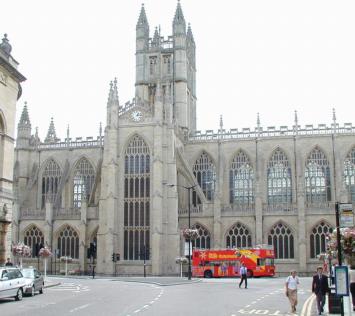
Fig 1. The tour bus waiting for custom in front of Bath Abbey
Like Oxford you can ride on an open topped 'Guide Friday' tourist bus with a commentary. You can also buy a 'Smart Pass' which will enable you to get reduced fares at many of the popular attractions and museums including the Roman Baths, and the Jane Austen Centre; details from www.bathpass.com or tel: 0870242 9988. This is probably worth getting, since most of the places of interest charge a modest entrance fee. The museums are mostly privately owned commercial businesses which are open all day, most have associated coffee shops.
Getting Started
The poster has a map, with a scale but no arrow indicating the direction of
North. There is no suggested order in which to visit the sites, nor exact
instructions on how to get from one to the next. Instead red circles on
the map are joined by a red line to a description of the site.
The introduction says:
'Bath is so much more than the baths, Royal Crescent, and Jane Austen. In
earlier times, before science and engineering turned professional, such
invention and discovery was undertaken by wealthy fashionable people
(Gentlemen essentially). Such people went to fashionable places such as
Bath, so it is perhaps no great surprise that Bath was a real hotbed of
science and engineering during the 18th and 19th centuries.'
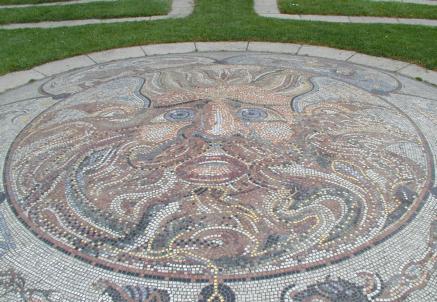
Fig2 shows where I started, at the Beazer Gardens Maze beside the Avon river near Poultney Bridge. This is an elliptical maze created in 1984 by Adrian Fisher when the theme of the Bath Festival of the Arts was 'The Maze'. The circular centre is a mosaic showing a copy of 'Sulis', a Gorgon's head carving found on a pediment of the nearby Roman temple.
You may find it easier to start at the BRLSI in Queen Square which has a wide range of activities and exhibitions and helpful staff. It is built on the site of the house of Dr William Oliver (1695-1764), who was a founder of the Mineral Water Hospital and invented the 'Bath Oliver' biscuit as part of his cure for rheumatic diseases.
The Roman Baths are fed by local hot springs which contain many minerals. Richard Strutt (1847-1927) and Sir James Dewar (1842-1923 inventor of the Thermos flask) detected helium in these waters. Sir William Ramsey (1852-1916 a Noble Prize winner for chemistry) detected radium.
My impression was that most of this trail is concerned with Victorian industrial innovation and engineering projects such as the building of the nearby Kennet and Avon Canal. Some day I should like to visit the Claverton Pumping Station and the Dundas Aqueduct which carries the Kennet and Avon Canal across the Avon Valley at Limpley Stoke over the river and the railway.
In the city I looked for the lodgings of William Smith (1769-1839) who came to Bath as a surveyor for mining companies, while staying in Bath he dictated his work 'The order of the strata'. He was the first person to realise that rock and sediment were laid down in a regular sequence identified by the fossils contained in the layers. The leaflet gives some addresses where he lived and had his offices, but little is left of his activities there. I spent some time searching for the address and finally decided that it had been obliterated by a smooth Bath stone modern office building, without even a small commemorative plaque.
The highlight of the trail for a physicist is the Museum in the Herschel House, (open afternoons) where William Herschel, the discover of Uranus and his sister Caroline, a comet watcher, lived for some years. His telescope is on view but is too big for me to photograph easily inside the small room. He was an accomplished musician and conducted the first performance in Bath of Handel's Messiah.
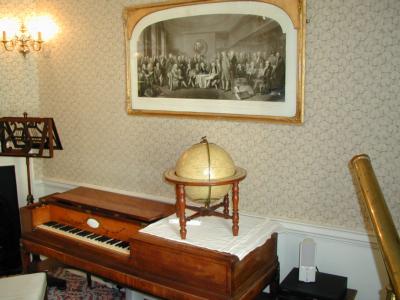
Fig3 shows his music room and small telescope. The background music which was playing in the entrance hall was one of his compositions, which can be purchased on a CD in the shop.
Outside in the garden where he did his observing is a sundial, a sculpture of William and Caroline and fixed to the wall a GREEN plaque (not one of their usual blue ones) erected by the IoP which reads:
Here lived
Scientist and Musician
Sir William Herschel
1738 - 1822
from where he found the planet
Uranus March 13th 1781
he also discovered
infra-red radiation in 1800
~and his sister~
Caroline Herschel
an early woman scientist
1750 - 1848
Hunter of comets
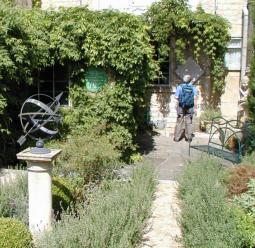
The last place I visited was the Museum of Bath at Work which houses the engineering collection of the Victorian entrepreneur Jonathan Burdett Bowler, who manufactured ginger beer in stone bottles. Fig 5 shows his office resplendent with typewriter and clock.
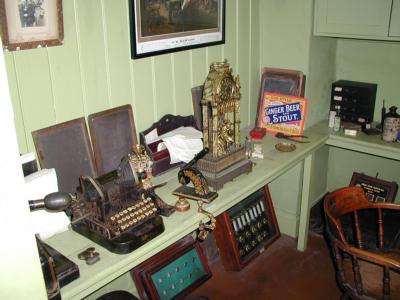
Other industries represented there are weaving, power generation, brewing, car making and ship building.
There is plenty to see on this trail, if you wish to stay longer than a day you might enquire of the Landmark Trust, who maintain flats in several houses in the city, Elton House just round the corner from Abbey Square, Marshal Wade's House is in the square itself above the National Trust shop, or if you prefer staying in a folly, you can rent a holiday apartment for a few days in the Beckford's Tower on Lansdown Hill two miles north of the city. The tower is also open to visitors at weekends between March and October.
Further information about:
Kate Crennell
February 2002
kmcrennell@physics.org